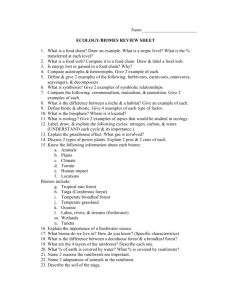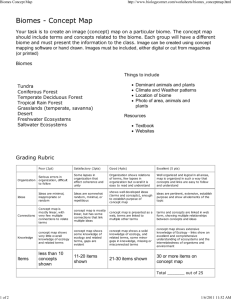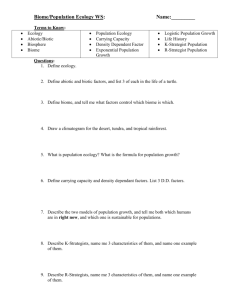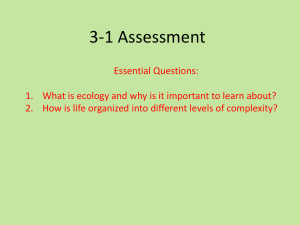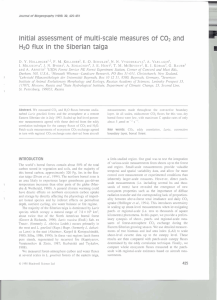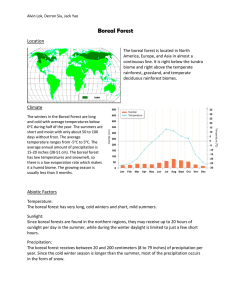Biology 137 Semester II Final Exam Review
advertisement
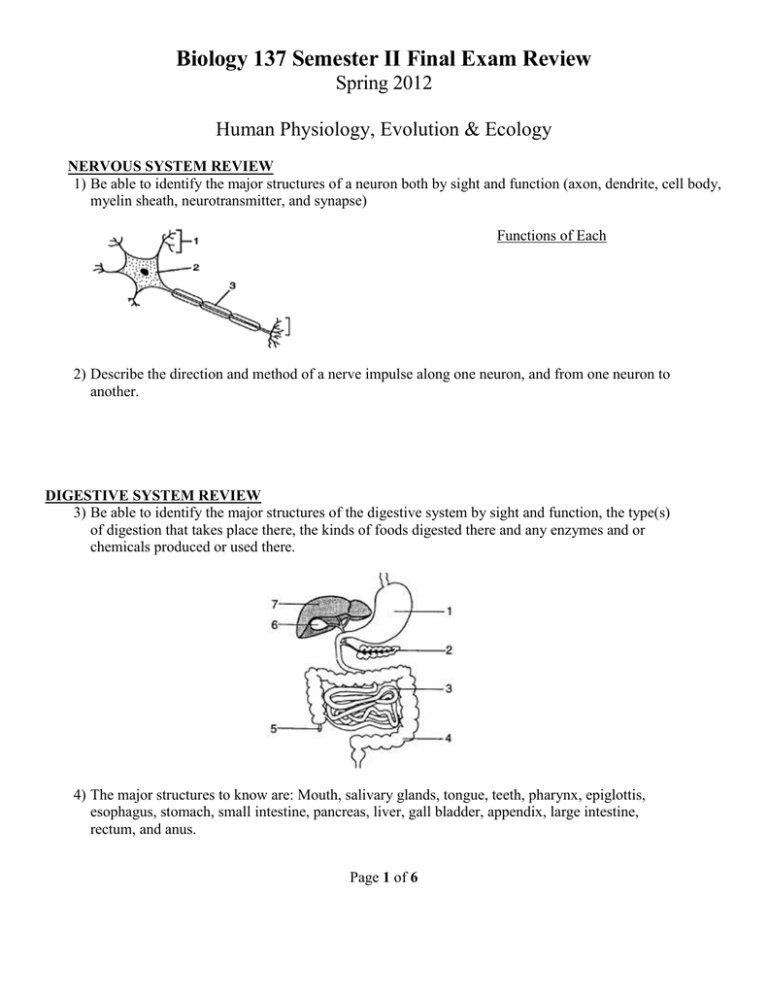
Biology 137 Semester II Final Exam Review Spring 2012 Human Physiology, Evolution & Ecology NERVOUS SYSTEM REVIEW 1) Be able to identify the major structures of a neuron both by sight and function (axon, dendrite, cell body, myelin sheath, neurotransmitter, and synapse) Functions of Each 2) Describe the direction and method of a nerve impulse along one neuron, and from one neuron to another. DIGESTIVE SYSTEM REVIEW 3) Be able to identify the major structures of the digestive system by sight and function, the type(s) of digestion that takes place there, the kinds of foods digested there and any enzymes and or chemicals produced or used there. 4) The major structures to know are: Mouth, salivary glands, tongue, teeth, pharynx, epiglottis, esophagus, stomach, small intestine, pancreas, liver, gall bladder, appendix, large intestine, rectum, and anus. Page 1 of 6 5) Know the four types of food (fats, lipids, carbohydrates, & proteins), what they are used for, what they break down into (Their building blocks), where they are digested, and the enzymes and\or chemicals used to digest them. Food Type What Are They Used For? What Do They Break Down Into? Where Are They Digested? Enzymes/Chemicals Used to Digest Them Fats Lipids Proteins Carbohydrates 6) What is peristalsis? When and where does it occur in the digestive system…be specific? Why is peristalsis necessary? CIRCULATORY SYSTEM REVIEW 7) Label the 4 chambers of the heart and their valves. 8) List in order the chambers and vessels of blood flow through the heart and lungs. Include the relative oxygen and carbon dioxide levels at various points (high/low). 9) List the three types of blood vessels and describe their unique qualities 1. 2. 3. Page 2 of 6 10) List the major vessels and where they lead. (Pulmonary artery and vein, Aorta, Inferior and superior vena cava). 11) What makes up blood? List the major components of blood and their jobs. SKELETAL/MUSCULAR/RESPIRATORYSYSTEM REVIEW 12) Be able to identify the major structures of the skeletal system and know their functions. 13) Be able to identify the major structures of the muscular system and know their functions. 14) Be able to identify the major structures of the respiratory system and know their functions. 15) Know the difference between a tendon and a ligament. Page 3 of 6 16) Know the different types of joints in the skeletal system and where they are found in the body. 1. 2. 3. 17) Know the three types of muscle tissue, where they are found and whether they are voluntary or involuntary. Muscle Tissue Type Where Are They Found? Voluntary/Involuntary 18) What is compact bone, spongy bone and bone marrow? 19) What is ossification and how does it occur? 20) What is the definition of respiration and what is being exchanged in this process? 21) What is the difference between the pharynx and the trachea? 22) What part of the respiratory system is responsible for you being able to make sounds…like talking and singing? 23) What is the purpose of the diaphragm? 24) Describe the process of how gas is exchanged in the lungs? Page 4 of 6 ECOLOGY/EVOLUTION REVIEW 25) Put these in order from simple to most complex: Biome, Organ, Biosphere, Organism, Cell, Population, Community, Organ System, Ecosystem, and Tissue. 26) Define the following terms: Term Definition Ecology Term Food Web Food Chain Trophic Levels Primary Consumer Secondary Consumer Producer Abiotic Biotic Species Population Niche Carnivore Community Detritivore Exponential Population Growth Renewable Resources Non-Renewable Resources Density-Dependent Limiting Factors Definition Density-Independent Limiting Factors 27) List the basic climate, any unique attributes, and organisms of each biome (Desert, Boreal forest/Taiga, Rain forest, Deciduous forests, and Grasslands) Biome Climate Unique Attributes Organisms Found There Desert Boreal Forest/Taiga Tropical Rainforest Deciduous Forest Grasslands Page 5 of 6 28) Define the term Evolution and give an example of how does it relates to a particular species. 29) Describe the process of ecological succession and define a pioneer species. 30) Define homologous, analogous and vestigial structures and give an example for each. Structure Type Definition Example Homologous Analogous Vestigial 31) Who is Charles Darwin? What are the main points to his theory? 32) Explain the following concepts: adaptation, natural selection, genetic variation, speciation, genetic drift, geographic isolation, and reproductive isolation. 33) Define the term fossil and know what a fossil record is used for. 34) Define homeostasis and relate the concept to the human body and to ecology. Good Luck!! You’re going to do great!! Page 6 of 6
